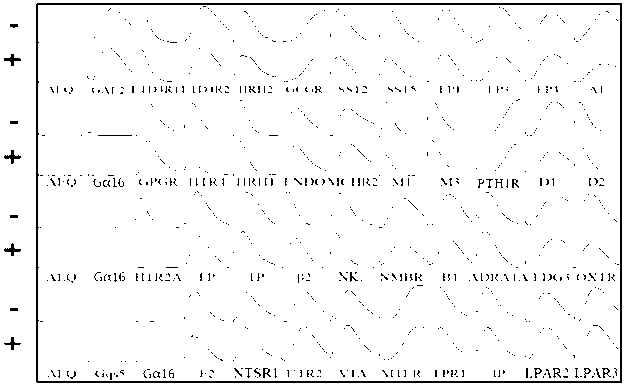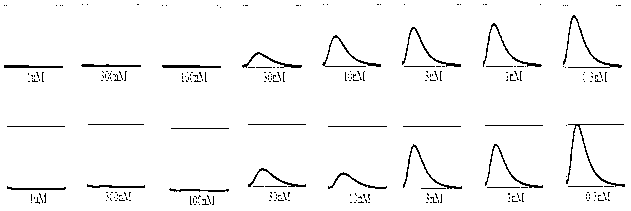Detection method for compound specificity through G protein-coupled receptor (GPCR)
A compound and specific technology, which is applied in the determination/inspection of microorganisms, biochemical equipment and methods, and the introduction of foreign genetic material using vectors, etc., can solve the problems that conventional customers cannot bear, cannot be applied at the same time, and are expensive, etc. Good repetition, low cost, and the effect of reducing product cycle and cost
- Summary
- Abstract
- Description
- Claims
- Application Information
AI Technical Summary
Problems solved by technology
Method used
Image
Examples
Embodiment 1
[0056] Substance P activates tachykinin receptors (NK 1 ) dose effect detection
[0057] Substance P is a neuropeptide widely distributed among nerve fiber cells, which is NK 1 A natural agonist of receptors, its main function is to transmit pain information, participate in the regulation of sensation, movement, emotion, etc., and is also related to the pathogenesis of anxiety, depression, and schizophrenia.
[0058] Express NK 1 A method for preparing recombinant HEK-293 cells, comprising the following steps:
[0059] (1) Preparation of HEK-293 cell suspension: HEK-293 cells (purchased from ATCC; the same below) were mixed with 6×10 5 The concentration of cells / mL was suspended in Free Style 293 medium (purchased from Life Technologies; the same below) containing 0.05% (mass volume ratio; the same below) F-68 (purchased from Sigma-Aldrich; the same below), At 37°C, 5% CO 2 Environment, 160rpm suspension shaking culture for 24 hours;
[0060] (2) Preparation of plasmid m...
Embodiment 2
[0073] Detection of GPCRs that specifically bind to Ritanserin
[0074]Ritanserin is a blocker of 5-hydroxytryptamine receptor (5-HTR, a G protein-coupled receptor), and has a selective blocking effect on 5-HTR. In peripheral tissues, 5-THR mediates vasoconstriction and smooth muscle contraction, and is an effective antagonist in response to 5-hydroxytryptamine (5-HT)-induced vasoconstriction and bronchospasm, and has the effect of reducing hypertension.
[0075] A method for preparing recombinant HEK-293 cells expressing different types of GPCRs, comprising the following steps:
[0076] (1) Preparation of HEK-293 cell suspension: HEK-293 cells were mixed with 6×10 5 Suspension culture at the concentration of cells / mL in Free Style 293 medium containing 0.05% F-68, at 37°C, 5% CO 2 Environment, 160rpm suspension shaking culture for 24 hours;
[0077] (2) Preparation of plasmid mixture: different GPCR plasmids (total 40 kinds, respectively GAL2, LTD4R2, LTD4R1, HRH2, GCGR, S...
Embodiment 3
[0095] Detection of Dose Effect of Ritanserin Inhibiting 5HTR Receptor
[0096] The preparation steps of recombinant HEK-293HEK-293 cells expressing HTR4 and HTR2A are as follows:
[0097] (1) Preparation of HEK-293 cell suspension: HEK-293 cells were mixed with 6×10 5 Suspension and dispersion culture at the concentration of cells / ml in Free Style 293 medium containing 0.05% F-68, 37°C, 5% CO 2 , 160rpm suspension shaking culture for 24 hours.
[0098](2) Preparation of plasmid mixture: Add HTR4 plasmid, G protein mutant plasmid, and aequorin plasmid at a mass ratio of 3 / 1 / 1 (unit: 0.1 μg / mL cell suspension) to Free In Style293 medium, the plasmid mixture of the HTR4 group was obtained; the preparation method of the plasmid mixture of the HTR2A group was the same as that of the HTR4 group;
[0099] (3) Prepare the transfection complex: Add polyethyleneimine to 50 μL serum-free medium in an amount twice the mass of the luminescent protein particle to obtain PEI reagent; mix...
PUM
 Login to View More
Login to View More Abstract
Description
Claims
Application Information
 Login to View More
Login to View More - R&D
- Intellectual Property
- Life Sciences
- Materials
- Tech Scout
- Unparalleled Data Quality
- Higher Quality Content
- 60% Fewer Hallucinations
Browse by: Latest US Patents, China's latest patents, Technical Efficacy Thesaurus, Application Domain, Technology Topic, Popular Technical Reports.
© 2025 PatSnap. All rights reserved.Legal|Privacy policy|Modern Slavery Act Transparency Statement|Sitemap|About US| Contact US: help@patsnap.com



